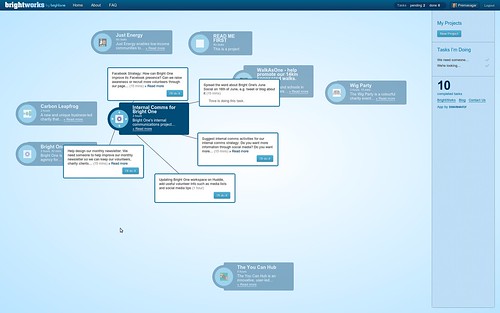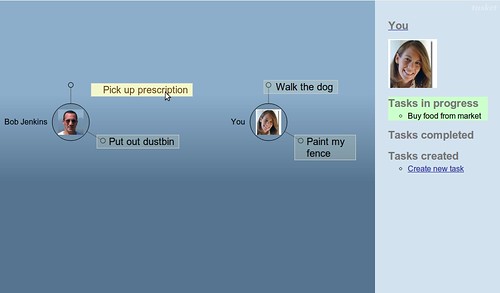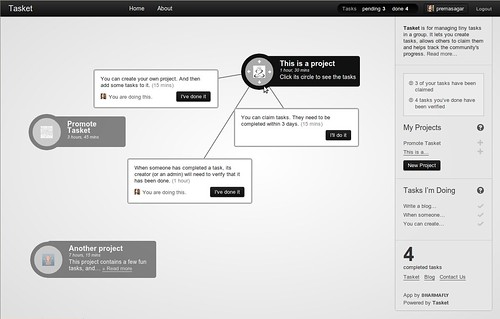URL: tasket.dharmafly.com
People like to help out with a good cause, but it can be difficult to find the time. What if, through the Web, we could gather enough people and bring them together to achieve something great?
At Dharmafly, we’ve been hard at work creating an open source tool called “Tasket“, which we hope will do just that. It’s a visually immersive web app, riffing off some of our data visualisation work, that engages volunteers in performing tiny tasks for a cause.
Essentially, it’s a “micro-volunteering” task management tool that lets people create tasks that need doing. Anyone can claim those tasks and Tasket helps everyone track the progress of the community.
BrightWorks: mobilising the crowd
We’ve designed Tasket with the not-for-profit company Bright One, who enable volunteers to work on projects for charities and third sector organisations. Bright One are an ethical Public Relations agency who provide a specialist, low-cost service for social good organisations, by connecting student volunteers with expert mentors. They help their volunteers to train and gain skills, and to work together as a cohesive team.
Using Tasket, we’ve built a website for Bright One called “BrightWorks“. The first version has just launched.
Bright One have only been going for two years, but in that time they have grown to be impressively successful – so much so that they have too many volunteers and too many charities wanting to get involved. It’s what you call “a nice problem to have”.
They needed a way to activate their volunteers more quickly, increase their capacity to work on more campaigns, and help everyone to stay informed and engaged with each other’s projects. BrightWorks now helps them to maximise their output from a dispersed, but eager, crowd of individuals.
The leaders of each project add information to the website, posting the highest priority tasks to be done. Anyone can offer to take on a task. And when a task is complete, it can be verified by its creator. Each volunteer accumulates a record of completed tasks (which in future might be used as part of a CV or resumé, or plugged into the volunteer’s professional profile on LinkedIn).
Gaming
There is a light layer of game dynamics incorporated into the web app. Projects rise and fall, as the weight of their tasks is unburdened by people completing them. Tasks can only take a maximum of four hours each, so a heavy task will need to be broken down into smaller ones. A volunteer can only take a limited number of tasks at one time, and there is a time limit for them to complete each one. (Tasket lets all these variables be configured for the requirements of its target website).
In future, we would love to add analytics, to show the performance of the community. We’d also like to expose the networks that emerge when people become connected via the projects that they contribute to. The tasks are a kind of currency; it’s actually the connections created between people that matter within the community.
Oh, and I’d also add to the wishlist: task notifications, alerts, messaging… and an app-load of other features.
Early feedback
What people have said so far:
The BrightWorks concept is genius because it fits right into a mould that we are all already comfortable with – microblogging. BrightWorks has taken a social networking concept and adapted it to the needs of non-profit organizations and volunteers – giving them the ideal meeting ground to actually get something done.
I love the idea of a more loose visual representation of a collection of tasks. It’s an area that’s been vexing us for a while… how to say “I’ll do this” for any given component of a larger project. All around, one of the most interesting/ smart/ exciting microvolunteering apps that I’ve seen to date.
Really lovely concept, like the dashboard-style interface – makes it feel like a tool rather than a site. The sign up form is very slick and quick. Also big bonus points for the photo upload being one-step: no resizing, no restrictions. Just works.
Sometimes, people are more than willing to volunteer yet have very little time to look for charities. And that is really frustrating. Well, if this new application manages to take off then that should stop being a problem.
Tasket for Carers: a prototype
Early on, before we started building Tasket, we presented a prototype for the concept at the Government’s “DotGovLabs Developer Weekend“, organised with Rewired State. Our frame of reference was a bit different – instead of dealing with projects, the main focus was on carers – people who live with and care for others.
There are 6 million carers in the UK (that’s one in ten). Many suffer from being overburdened, isolated and stressed. Poor health and depression can often result. We believe that, if carers could get help with just the little things in their daily lives, the result could be a big improvement in their quality of life.
Our 24-hour prototype shows how Tasket could be used to let carers add tiny tasks, such as collecting groceries or putting out the rubbish, and allow friends, family or neighbours to complete those tasks for them.
The prototype was a success. We won the Government’s “Carers” category prize. You can take a look here: dharmafly.com/tasket-carers-prototype/
We’ve gone on to make it into the DotGovLabs top 3 innovative solutions for the extended project.
Play in the sandpit
You can have a play with the open source Tasket app (in glorious black n’ white), at tasket.dharmafly.com
Go ahead, sign up, create a project, add some tasks. You can claim tasks that others have created, click around, explore. And remember, because it’s all open source, you can re-use the code for your own task management applications (or contact Dharmafly to adapt it for you).
One data server, many apps
We’ve built the server as a kind of pure data engine. How the actual application looks and behaves can be wildly different, but still use the same underlying data.
As an example, the screenshot above shows a notepad style “to do” list manager, built on Tasket. It’s much more focussed on an individual and their own tasks, but could equally be used for sharing lists between a group of people. A very early version of the app can be seen here.
A little note on technology (for the geeks)
Tasket uses a collection of HTML5-related technologies. It is a “thick client”, built with the JavaScript library Backbone.js, and communicates with a JSON-based API (e.g. here are all the unfinished tasks on BrightWorks). The server is created with the Python-based framework, Django (this may be swapped with Node.js in future).
Projects and tasks are laid out with force-directed physics, to prevent them from overlapping each other and the walls of the website. The lines connecting tasks are in SVG (although the circles that represent each project instead use simple CSS3 border-radius).
You can download the code and run it on your own server (it has the permissive MIT license), or fork the project on GitHub. Improvements and pull requests are welcome.
Created by
Tasket and BrightWorks have been brought to you by:
- Matt Weston – social design
- Gavin O’ Carroll – visual design
- Sym Roe – server-side
- Aron Carroll – JavaScript, CSS
- Kyran Dale – force-directed physics
- Christian Thrower, Ollie Bettany and Andrea Fiore – front-end design & dev for the Notepad app
- Prem (that’s me) – concept, JavaScript, coordination
- …and the brilliant minds at Bright One. Big thanks especially to Ben, Katy and Dan.
You can follow the further developments of the BrightWorks project on its blog.



